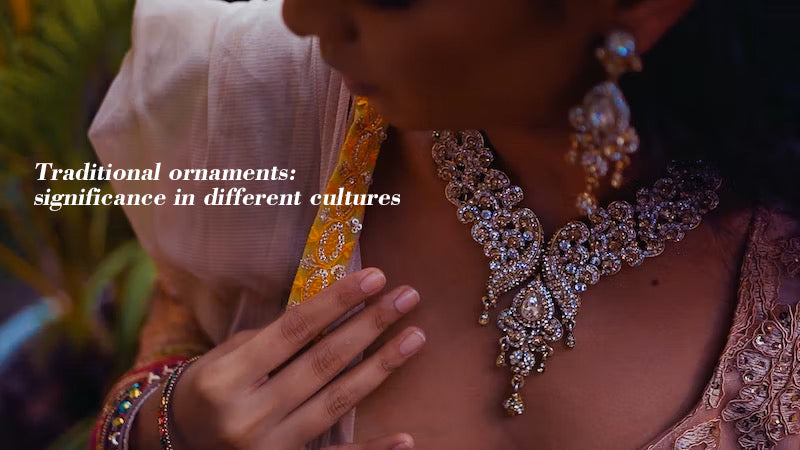Traditional ornaments: significance in different cultures

Ornaments have played a significant role in human history and have been a part of human culture since ancient times.
Traditional ornaments are symbols of status, beauty, and cultural identity, and are worn for various reasons, including religious, cultural, and aesthetic purposes.
In this article, we will explore the traditional ornaments and their significance in different cultures around the world.
https://www.oraneden.com/collections/earrings/products/abyssal-gold-stud-earrings
India
India has a rich cultural heritage, and its traditional ornaments reflect its diverse and ancient history.
Traditional Indian ornaments are often made of gold, silver, or other precious metals, and are adorned with precious and semi-precious stones.
In Indian culture, ornaments hold immense value and are considered to be symbols of wealth, status, and power.
The most common traditional Indian ornaments include bangles, necklaces, earrings, toe rings, and anklets.
Mehendi or Henna tattoos are also a significant part of Indian culture, and women often apply intricate designs on their hands and feet during festivals and other important events.
These designs are often inspired by traditional Indian jewelry and serve as an extension of the adornments.
https://www.oraneden.com/collections/earrings/products/tassel-decor-hoop-earrings
In Indian culture, traditional ornaments also hold religious significance. For example, the Mangalsutra is a necklace that is worn by married women, and it symbolizes the union between a husband and wife.
The nose ring or Nath is worn by women in different parts of India, and it symbolizes their marital status.
China
In Chinese culture, traditional ornaments are an important part of social and cultural life.
Chinese traditional ornaments are often made of jade, gold, silver, and other precious metals, and are decorated with intricate designs and precious stones.
In Chinese culture, jade holds a significant place, and it is believed to have healing powers and bring good luck.
The Chinese often wear jade ornaments, such as bracelets and necklaces, as a way to ward off evil spirits and attract good fortune.
https://www.oraneden.com/collections/earrings/products/voice-of-soul-tassel-earring-clip-crystal
In Chinese culture, the use of traditional ornaments is also influenced by feng shui principles.
Feng shui is an ancient Chinese art of arranging objects to create a harmonious environment. In feng shui, the use of certain colors, shapes, and materials in traditional ornaments is believed to bring balance and harmony to one's life.
Africa
In African culture, traditional ornaments hold immense cultural and social significance.
African traditional ornaments are often made of wood, beads, and other natural materials, and are adorned with intricate designs and patterns.
In African culture, traditional ornaments are a symbol of social status, and they are often worn during important ceremonies and celebrations.
The ornaments also reflect the cultural identity and heritage of the wearer.
https://www.oraneden.com/collections/necklaces/products/kali-necklace
In African culture, beads are particularly significant, and they are often used to make necklaces, bracelets, and anklets.
The beads are often arranged in intricate patterns, and each pattern has its own unique meaning and symbolism.
Native American
In Native American culture, traditional ornaments are a significant part of the spiritual and cultural life of the community.
Native American traditional ornaments are often made of silver, turquoise, and other natural materials and are adorned with intricate designs and patterns.
In Native American culture, the use of traditional ornaments is often tied to spiritual beliefs and practices.
For example, the dreamcatcher is a traditional Native American ornament that is used to ward off bad dreams and promote good dreams.
The dreamcatcher is often made of wood, feathers, and beads, and it is believed to have spiritual and healing powers.
The use of traditional ornaments is also tied to the cultural identity of Native American communities.
Traditional Native American ornaments often feature tribal designs and symbols that reflect the history and heritage of the community.
https://www.oraneden.com/collections/bracelet/products/clinch-bracelet
Middle East
In Middle Eastern culture, traditional ornaments hold a significant place and are often associated with religious and cultural beliefs.
Islamic art has influenced the design of traditional Middle Eastern ornaments, and many of them feature intricate geometric patterns and calligraphy.
The use of traditional ornaments in Middle Eastern culture is also tied to social status and cultural identity.
For example, the hijab pin is a traditional Middle Eastern ornament that is worn by women to secure their headscarves.
The hijab pin is often made of gold or silver and is adorned with precious stones, and it is a symbol of a woman's cultural and religious identity.
https://www.oraneden.com/collections/rings/products/galina-ring-rose-gold
In some Middle Eastern cultures, traditional ornaments are also believed to have healing properties.
For example, the Hamsa, a hand-shaped amulet, is believed to protect the wearer from the evil eye and bring good fortune.
The Hamsa is often made of gold or silver and is decorated with precious stones and intricate designs.
In summary, traditional ornaments are an essential part of cultural identity and heritage in many parts of the world.
The significance of these ornaments is deeply ingrained in the cultural and religious beliefs of different communities, and they often hold social and symbolic value.
From the intricate patterns of Native American ornaments to the religious symbolism of traditional Indian ornaments, traditional ornaments serve as a reflection of the diverse history and culture of human civilization.








